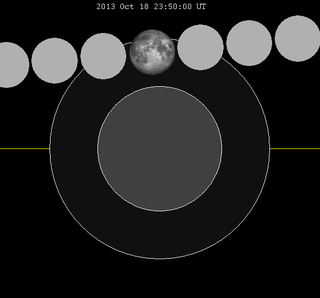Lunar eclipse 2013: Where to see October 18 penumbral lunar eclipse
This year’s final penumbral lunar eclipse is set to take place on Friday, October 18, when the moon will appear much dimmer and redder than normal.
The lunar eclipse will be visible to people living in Europe, Africa, the Americas and parts of Asia just before midnight GMT.
The partial lunar eclipse will be visible Friday into Saturday night for those living from eastern Canada and the upper Northeast to Africa and most of Europe.
The eclipse will be most visible for the US and Canada at 7.50 p.m. EDT.
At 23:51 UTC, the fullest coverage of the moon by Earth’s shadow will occur, lasting for 239 minutes. Due to the timing of the eclipse, the moonrise will not be high enough for western parts of North America to view; its peak will not reach so far west and will only be visible for Africa and Europe.
A penumbral lunar eclipse is when the moon passes through Earth’s shadow – the penumbra is the wider region where only a portion of light source is obscured by the planet.
The phenomenon only occurs when the moon passes directly behind Earth into its shadow, leaving all three celestial bodies aligned. The lunar eclipse will be visible for several hours.
Stargazers in Europe look set to get the best view of the eclipse as it will occur when the night sky is at its darkest.
For the parts of the US and Canada that the eclipse will reach, cloud coverage will hinder the view for a large area, especially in Canada. Two slow-moving storm systems will bring rainy and cloudy conditions to much of Canada Friday evening. Some areas in the Saint Lawrence River Valley may get breaks to catch a glimpse of the moon, but most of Eastern and Atlantic Canada will miss out on the viewing. Conditions will be mostly clear for the small portion of the northeastern US that the eclipse will extend into.
During a penumbral eclipse, the moon appears darker and redder because the sun’s light is being filtered through the Earth’s atmosphere, which eliminates much of the “blue light”.
Unlike viwing a solar eclipse, lunar eclipses may be viewed by staring directly at them. They also won’t require any additional equipment, such as telescopes or binoculars. Areas that have clear skies will be able to see it the same way they’d typically view the moon. Because this eclipse will only have a partial shadow, the difference may not be as noticeable to the general public.
Most of Europe will have fair to good conditions at the time of the eclipse, where it will be visible at 12:50 a.m. WEST in Lisbon, Portugal, to 3:50 a.m. MSK Saturday in Moscow, Russia.
The best viewing conditions are expected in parts of Scandinavia as well as farther south across the Balkans. High pressure over these areas should promote mainly clear skies. These good viewing conditions will be sandwiched between two areas of poor viewing conditions. To the west, a large storm system will spread clouds across the British Isles and the western Iberian Peninsula, while another shield of clouds will cover the sky east of the Black Sea.
Elsewhere, a few clouds can spread eastward across central europe, but many people will be able to view the eclipse from Barcelona to Paris to Berlin and Rome.
Lunar eclipses occur about two to four times a year. Some of these are penumbral eclipses, which are so subtle that they hardly look like anything to the average observer.
This penumbral lunar eclipse will be the last one of the year. The next will not take place until April 2014.
[youtube L2mVp6O59k8 650]

